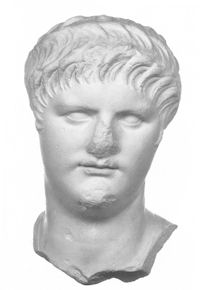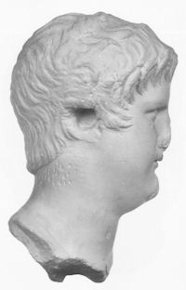
Figure 2: The Great Eastern Street head, London (Authors' photo courtesy of the Museum of London)
The first head to be examined as part of the pilot project (Figure 2), made from white Italian marble, was originally found in 1906 during a period of urban development in Great Eastern Street, London (Toynbee 1964, 50). Unfortunately, nothing appears to have been recorded at the time with regard to the exact circumstances of the discovery or of any potentially associated artefacts, and so its archaeological context remains unknown (Francis Grew pers. comm.).
Great Eastern Street in Islington, lies just over 2km to the north of Roman Londinium, in an area where there has been very little detailed archaeological investigation or, indeed, any comparable Roman finds (Francis Grew pers. comm.). The object was acquired by Guildhall Museum shortly after its discovery and was eventually transferred to the ownership of the Museum of London when the Guildhall and the London Museums merged in 1976. It is not currently on display.
The life-size head, measuring 18.2cm high from the base of the chin to the upper edge of the hair, and 14.8cm in width (ear to ear), is extremely battered (Figure 3), having become detached from the lower neck and shoulders in antiquity. The outline of the face is broad with a rather fleshy chin. The entire left and lower half of the face has been worn smooth, possibly as a result of exposure to the elements, something that could have occurred if the piece had been reused as building material.

Figure 3: 3D scan of the Great Eastern Street head (Bournemouth University). 3D PDF | WRL (VRML plugin required)
Most of the deeply set right eye and the inner part of the left survive, as do the ears and the approximate position of the nose. A series of slight indentations across the central and lower left-hand side of the face, especially towards the central area of the nose, suggest that facial damage may not have been entirely natural, and that the weathering to the nose, eyes, mouth and brow may originally have been facilitated by deliberate and sustained battering with a small hammer or chisel. A small group of circular indentations around the area of the right ear and upper neck may indicate further mutilation conducted at the time of decapitation or deposition.
The coiffure, a tiered effect of long, individual locks, survives well, especially across the right side of the forehead where the hair is lifted up into a discrete crest. The fringe, across the right side of the face, appears to have comprised strands of hair arranged in parallel curls curving right to left. This arrangement reverses direction above the right eye. The hair on the nape of the neck is long and combed forwards, towards the ears. Traces of extended sideburns can be seen curling over the surviving right ear. There are slight indications of facial hair, lightly incised as individual swirls, detectable across the right side of the jaw and below the chin.
The identification for the Great Eastern Street head is derived from a number of factors, the most telling of which is the hairstyle, clearly distinguishable within the 3D scan, referred to by the Roman biographer Suetonius as coma in gradus formata (literally 'shaped into terraces') when so eloquently describing the crested coiffure of Nero in the latter years of his reign (Suetonius Nero 51). That this head was originally of the fifth emperor cannot be in doubt for, aside from the distinctive hairstyle, found in no other sculptured portrait of the period, the overall facial proportions combined with the nature of the deep-set eyes and brow match known portraits of this particular princeps (Figure 4).
The changing sequence of Nero's portraiture from the time of his formal adoption by Claudius in AD 50 to his suicide in AD 68 has been well documented (e.g. Hiesinger 1975; Kleiner 1992, 135-9; Varner 2000, 126-30; 2004, 47-9), with at least four major portrait types having been identified (Kleiner 1992, 136-8; Varner 2004, 48), corresponding with the years AD 50-1 (his formal adoption by the Emperor Claudius), 54 (accession), 59 and 64 (established to commemorate the fifth and tenth anniversaries of his rise to power). The Great Eastern Street head, with its prominent, crested coiffure, resembling a crown or tiara (Varner 2000, 128), clearly belongs to one of the latter two portrait types, although damage sustained to the face makes it difficult to identify precisely which. The lightly incised beard and relatively 'less fleshy' nature of the cheeks, when combined with the nature of the fringe, thick curls combed from right to left in parallel strands, changing direction above the right eye, seems to indicate that the piece falls into the third major type dating from AD 59 (Varner 2004, 49), although variants are also known from the fourth and final type introduced in AD 64 (Kleiner 1992, 138-9; Varner 2004, 49).

Figure 5: Portrait of Nero from his third major portrait phase of AD 59-64, found on Palatine Hill in Rome (© Museo Nazionale delle Terme, Rome)
Parallels for the London Nero may be found in a better preserved sculpture from the third major portrait group, originally from the Palatine Hill in Rome and now in the collections of the Museo Nazionale delle Terme (Kleiner 1992, 138; Varner 2004, 48; reproduced here as Figure 5), and an example taken from the final phase of portraiture now held by Worcester Art Museum in the USA (Varner 2000, 17; 2004, 49; reproduced here as Figure 6).


Figure 6: Portrait and profile of Nero from his fourth major portrait phase of AD 64-8 (© Worcester Art Museum, Worcester, Massachusetts)
Internet Archaeology is an open access journal based in the Department of Archaeology, University of York. Except where otherwise noted, content from this work may be used under the terms of the Creative Commons Attribution 3.0 (CC BY) Unported licence, which permits unrestricted use, distribution, and reproduction in any medium, provided that attribution to the author(s), the title of the work, the Internet Archaeology journal and the relevant URL/DOI are given.
Terms and Conditions | Legal Statements | Privacy Policy | Cookies Policy | Citing Internet Archaeology
Internet Archaeology content is preserved for the long term with the Archaeology Data Service. Help sustain and support open access publication by donating to our Open Access Archaeology Fund.
File last updated: Tue Feb 05 2013